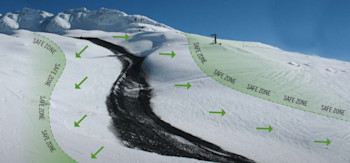
Skiing Mt Ruapehu: What you should know about the volcano
The snow at Mt Ruapehu attracts excited skiers and boarders, some of whom may not know that it is one of New Zealand’s most active volcanoes!
As you make your checks before heading up the mountain, consider what volcanic hazards you need to be aware of and how you can stay safe.
The most important thing: If there is an eruption or if the siren sounds on the ski area move sideways out of the valleys immediately.
What are the volcanic hazards? How do I prepare for them?
Active volcanoes can pose a threat to safety if they are not understood and people don’t take action to protect themselves.
Eruptions - Small eruptions only affect the summit plateau around Crater Lake. Larger eruptions can produce hazards that extend beyond the mountain top and could include: lahars, flying rocks, pyroclastic flows (hot ash and gas), lava flows, ashfall, and earthquakes.
Ruapehu’s vent is located under Crater Lake (Te Wai ā-moe), and the volcano makes itself known every decade or so with an eruption. Ruapehu last erupted in September 2007, producing a lahar.
An eruption could occur without warning. We continuously monitor the volcano for signs of activity and will update you using a Volcanic Alert Bulletin if there are any significant changes at the volcano.
On the mountain, Department of Conservation and Ruapehu Alpine Lifts have a world-class Eruption Detection System (EDS) to alert people on the mountain to immediately move to safety.
Lahars – Lahars are mudflows that are a mixture of volcanic ash and debris that move swiftly down mountain slopes, usually in valleys. Lahars could be generated by eruptions, or by a failure of the crater lake dam wall. Lahars are very fast-moving. You will not be able to ski or board your way out of its path. If you hear an alarm that instructs you to get out of a valley, do so immediately. Move sideways out of the valleys quickly, don’t ski down the valley.
For the 2019 ski season we have worked with Department of Conservation and Ruapehu Alpine Lifts to produce two new hazard map posters for Whakapapa and Turoa. The posters show the valleys at risk of lahars. If there is an eruption or if the siren sounds on the ski area move out of these valleys immediately.
What is the volcano up to?
GeoNet monitors Ruapehu and its crater lake – click here.
Crater Lake is now cooling, with a current temperature of 17°C. Research shows that the probability of an eruption increases when the lake is significantly warmer or cooler than the median temperature range (16-38°C), with a bias to a warmer lake.
Despite the current lower lake temperature, the likelihood of an eruption remains low. In the 12 years since the last eruption the lake has cooled eight times to below 16°C and heated seven times to over 38°C with no eruptions.
Ruapehu’s Volcanic Alert Level remains at 1, which indicates minor volcanic unrest.

